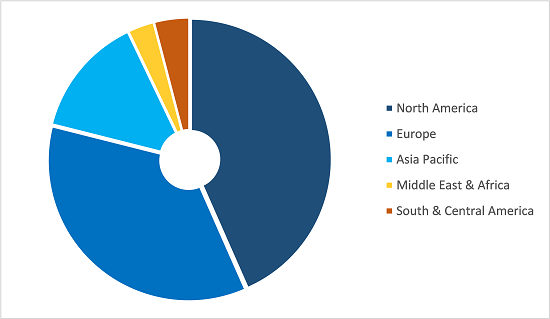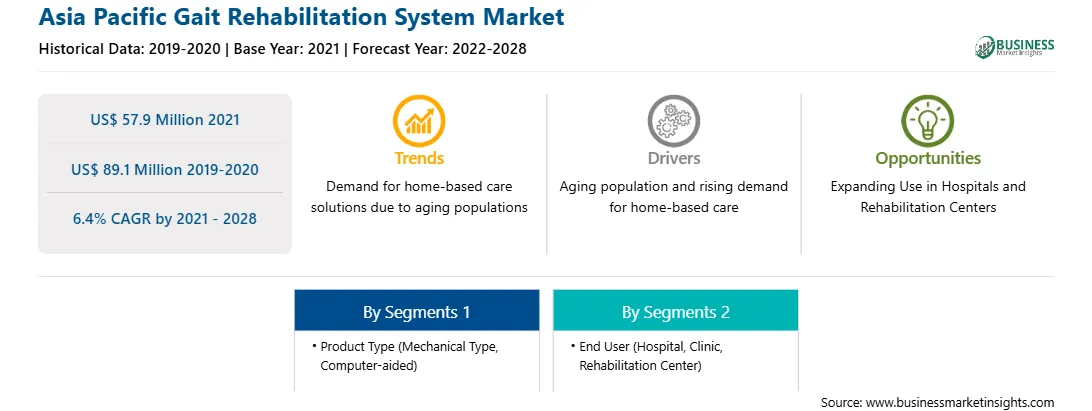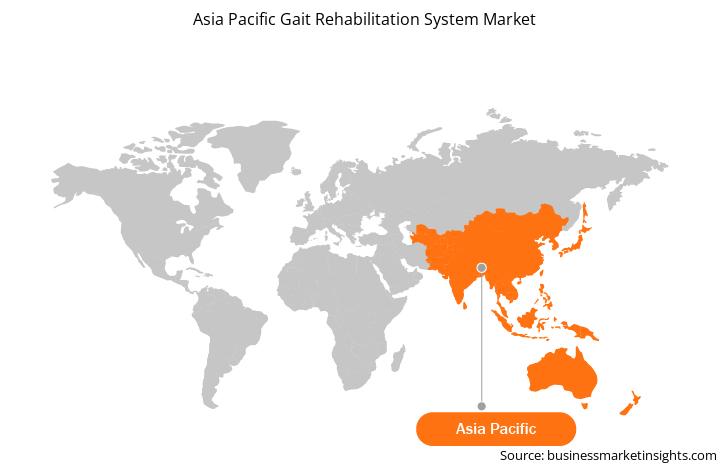Market Introduction
Most gait training systems are intended for acute and subacute neurological patients. Many techniques are used for relearning gait cycle training (functional gait training) or gait movements (nonfunctional training). Each system has its benefits and limitations in terms of functional outcomes. Though, training gait cycle movements are inadequate for the improvement of ambulation.
Moreover, the increasing incidence of neurological disorders, elevating number of sports injuries and orthopedic diseases cases to boost the market growth is driving the market’s growth. However, the availability of alternate therapies critically impacts the growth of the market.
The COVID-19 pandemic has largely affected the economies in the Asia-Pacific region. Countries like India, China, Japan, and South Korea have been affected by the pandemic. The socio-economy was badly hit, with negative inflation, GDP, and unemployment rising in the region. The pandemic has affected three main aspects of the global economy: manufacturing, supply chain, and business and financial markets. Japan, China, South Korea, India, and Australia are the hardest-hit countries due to the rising number of COVID-19 cases and related deaths. Medical device manufacturers and suppliers are shifting their focus to developing and supplying COVID-19 essentials and medical devices for respiratory diseases. This scenario harms the market. This pandemic is affecting the operations of the various key players operating in this region. Several physiotherapy clinics and centers have been closed from the 15th survey by the PPTA to determine the impact of COVID-19 on physiotherapy practice due to the country's lockdown. Robotics projects are currently being developed that may be cheaper than existing imported options. The research for the “AGAPAY project,” which was developed for rehabilitation after stroke, aims to create a biomimetic exoskeleton for the upper body, particularly for the shoulders, upper and forearms, wrists, and hands. According to Tenido, a LIF fellow from the Royal Academy of Engineering, the AGAPAY project aims to “help overburdened clinics and therapists while providing patients with reliable, easy-to-use, safe, affordable and effective treatment.” Exercises with the exoskeletons can be carried out semi-automatically so that a single therapist can care for several patients simultaneously. The robots track the patient's progress in real-time and can thus accelerate the recovery process.
Strategic insights for the Asia Pacific Gait Rehabilitation System provides data-driven analysis of the industry landscape, including current trends, key players, and regional nuances. These insights offer actionable recommendations, enabling readers to differentiate themselves from competitors by identifying untapped segments or developing unique value propositions. Leveraging data analytics, these insights help industry players anticipate the market shifts, whether investors, manufacturers, or other stakeholders. A future-oriented perspective is essential, helping stakeholders anticipate market shifts and position themselves for long-term success in this dynamic region. Ultimately, effective strategic insights empower readers to make informed decisions that drive profitability and achieve their business objectives within the market. The geographic scope of the Asia Pacific Gait Rehabilitation System refers to the specific areas in which a business operates and competes. Understanding local distinctions, such as diverse consumer preferences (e.g., demand for specific plug types or battery backup durations), varying economic conditions, and regulatory environments, is crucial for tailoring strategies to specific markets. Businesses can expand their reach by identifying underserved areas or adapting their offerings to meet local demands. A clear market focus allows for more effective resource allocation, targeted marketing campaigns, and better positioning against local competitors, ultimately driving growth in those targeted areas.
Asia Pacific Gait Rehabilitation System Strategic Insights

Asia Pacific Gait Rehabilitation System Report Scope
Report Attribute
Details
Market size in 2021
US$ 57.9 Million
Market Size by 2028
US$ 89.1 Million
Global CAGR (2021 - 2028)
6.4%
Historical Data
2019-2020
Forecast period
2022-2028
Segments Covered
By Product Type
By End User
Regions and Countries Covered
Asia-Pacific
Market leaders and key company profiles
Asia Pacific Gait Rehabilitation System Regional Insights

Market Overview and Dynamics
The Asia Pacific gait rehabilitation system market is expected to reach US$ 89.1 million by 2028 from US$ 57.9 million in 2021. The market is estimated to grow at a CAGR of 6.4% from 2021–2028. Neurological disorders are among the critical indications observed among people of all age groups. Different types of gait disorders include hemiplegic gait, diplegic gait, neuropathic gait, myopathic gait, choreiform gait, ataxic gait, parkinsonian gait, and sensory gait. Dragging one leg, sudden knee buckling or collapse, small and slow steps, excessive swaying, extra arm and leg movements disrupting the balance, crouching, and anxiety about falling are among the symptoms of a functional gait disorder. Every year, ~1.2 million adults are diagnosed with brain disorders, including 51.3% stroke patients and 21% Alzheimer’s disease patients, and ~135 million people are diagnosed with Parkinson’s disease, traumatic brain injury, and epilepsy. Moreover, ~500,000 brain tumor, multiple sclerosis, and amyotrophic lateral sclerosis cases are reported annually in the country. Such growing prevalence of neurological disorders is propelling the demand for neuromodulators that help relieve neurological symptoms. Thus, the rising prevalence of indications associated with gait disorders is driving the Asia Pacific gait rehabilitation systems market growth.
Key Market Segments
In terms of product type, the mechanical type segment accounted for the largest share of the Asia Pacific gait rehabilitation system market in 2020. In terms of end user, the hospitals segment accounted for the largest share of the Asia Pacific gait rehabilitation system market in 2020.
Major Sources and Companies Listed
A few major primary and secondary sources referred to for preparing this report on the gait rehabilitation system market in Asia Pacific are company websites, annual reports, financial reports, national government documents, and statistical database, among others. Major companies listed in the report are zebris Medical GmbH, PRODROMUS S.A., Reha Technology AG, DIH Medical, Meditouch, HIWIN Corporation, Restorative Therapies, Inc., Meden-Inmed Sp. z o.o., and Groupe WINNCARE.
Reasons to Buy Report
Asia Pacific Gait Rehabilitation System Market Segmentation
By Product Type
By End User
By Country
Companies Mentioned
The Asia Pacific Gait Rehabilitation System Market is valued at US$ 57.9 Million in 2021, it is projected to reach US$ 89.1 Million by 2028.
As per our report Asia Pacific Gait Rehabilitation System Market, the market size is valued at US$ 57.9 Million in 2021, projecting it to reach US$ 89.1 Million by 2028. This translates to a CAGR of approximately 6.4% during the forecast period.
The Asia Pacific Gait Rehabilitation System Market report typically cover these key segments-
The historic period, base year, and forecast period can vary slightly depending on the specific market research report. However, for the Asia Pacific Gait Rehabilitation System Market report:
The Asia Pacific Gait Rehabilitation System Market is populated by several key players, each contributing to its growth and innovation. Some of the major players include:
The Asia Pacific Gait Rehabilitation System Market report is valuable for diverse stakeholders, including:
Essentially, anyone involved in or considering involvement in the Asia Pacific Gait Rehabilitation System Market value chain can benefit from the information contained in a comprehensive market report.